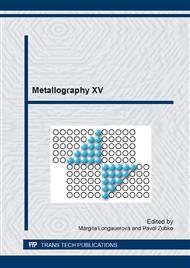p.263
p.269
p.275
p.279
p.284
p.288
p.295
p.301
p.306
Metallography of Low Alloy Cr-Mn Hot-Rolled Steel and Quantitative Evaluation of Grain Boundary- and Internal Oxides by TEM
Abstract:
Alloy elements undergo complex diffusion and segregation processes during steel production. Oxygen diffuses into the steel matrix and forms oxides at the surface (called scale), at the grain boundaries and within the grains. In our work we present assemblies and composition of various oxides found at the grain boundaries and within the grains of a low alloy Mn-Cr hot-rolled steel sheet. We utilise metallographic means (surface etching) and transmission electron microscopy (TEM). After etching we observe four zones of different composition: (i) the scale, followed by a decarburised metallic layer with (ii) oxidised grain boundaries, (iii) non-oxidised grain boundaries and last, (iv) the bulk. Via TEM, we analyse alloy element oxides at grain boundaries and within the grains with high spatial resolution. At the grain boundaries and within the grains we find oxides, such as Mn- or Cr oxides, rather than binary oxides (e.g. Fe-Mn- and Fe-Cr oxides) or even more complex oxides, such as Fe-Mn-Cr oxides. The oxide species found lie next to- or embedded amongst one another.
Info:
Periodical:
Pages:
284-287
Citation:
Online since:
April 2014
Authors:
Price:
Сopyright:
© 2014 Trans Tech Publications Ltd. All Rights Reserved
Share:
Citation:


